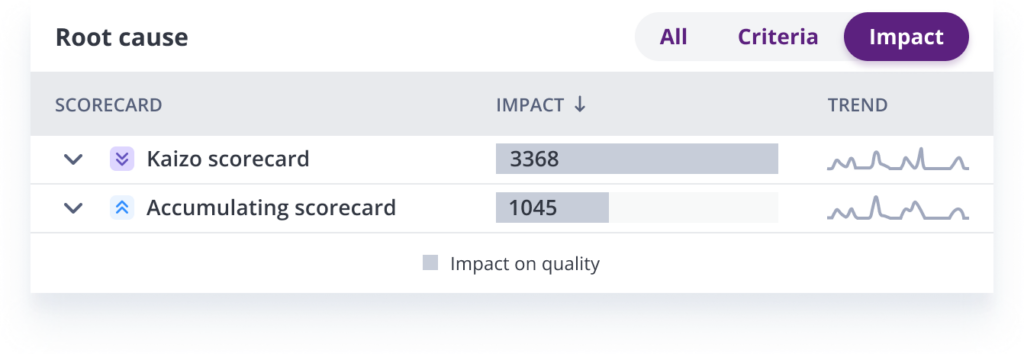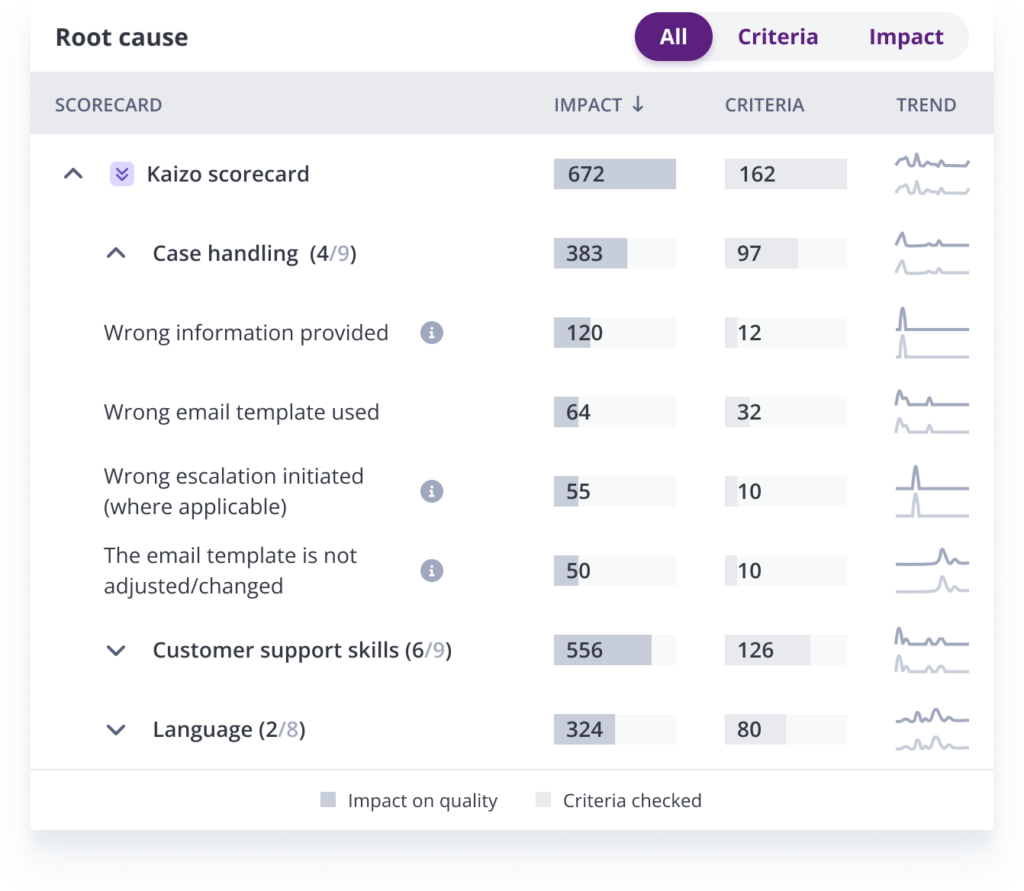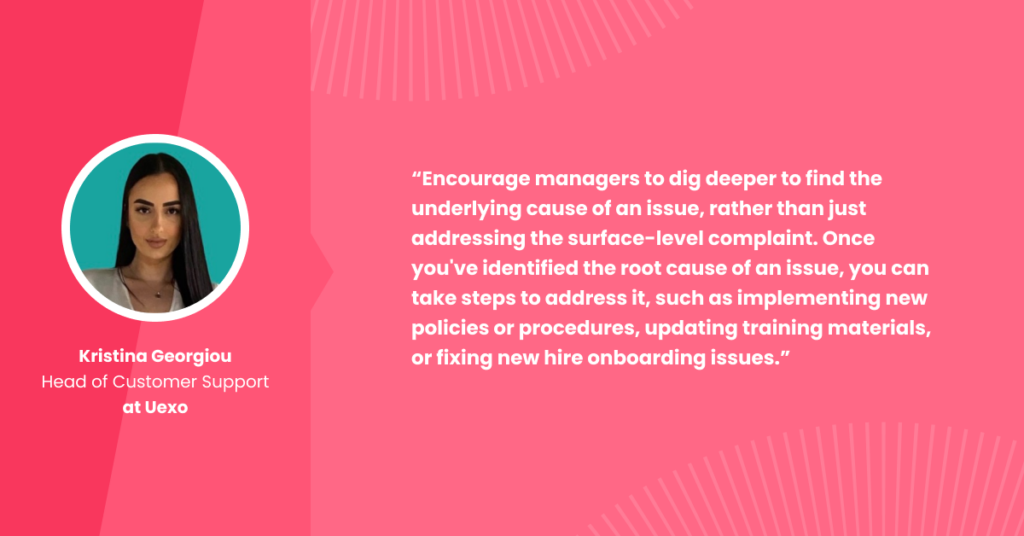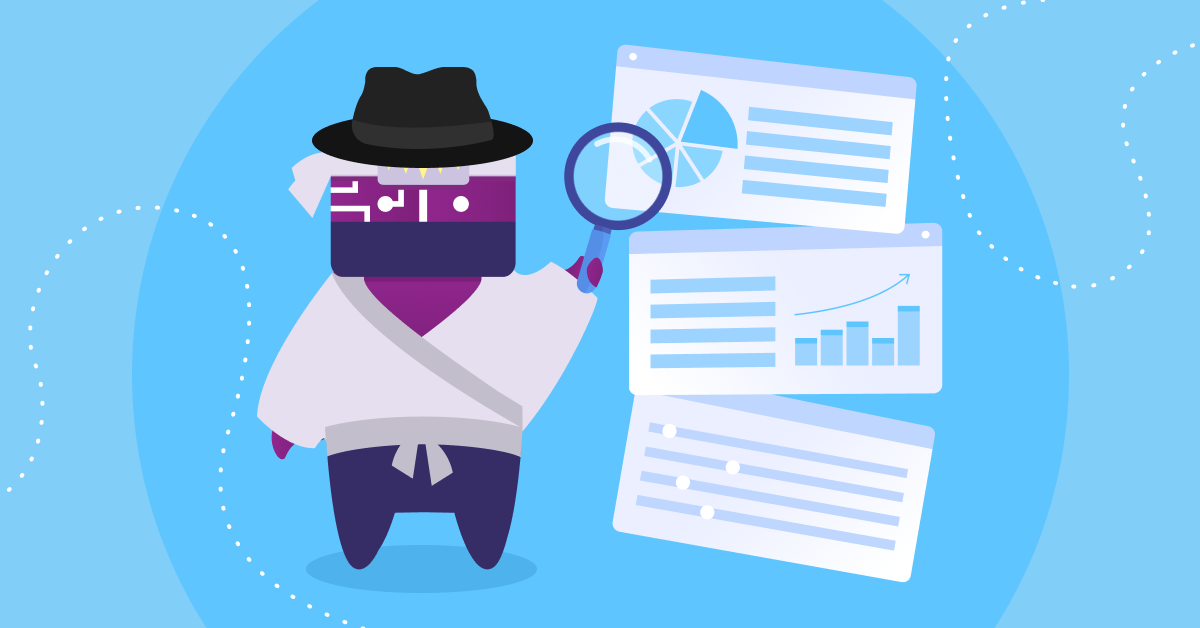Analyzing the Internal Quality Score (IQS) of your support efforts wouldn’t be complete without digging deeper into quality standards that agents don’t meet.
Or… understanding what type of tickets are most often impacted and what mistakes keep happening.
Whenever a customer has an issue, it’s important to first understand what the underlying cause of that problem is so you can provide consistent feedback to the team, organize coaching sessions, and strive to achieve the quality standards of your company.
Understanding the main problem behind an agent’s performance and behavior with customers will help you prevent similar issues from happening again. Plus, you’ll be able to take the right type of measures to improve performance, agent engagement, and motivation.
One powerful tool for improving agent performance in time is root cause analysis.
What is root cause analysis in quality assurance and customer service?
Root cause analysis (RCA) is a method that involves taking a close look at your agents’ tickets and the way they interact with customers to identify the underlying reason for common or vital issues.
It helps you find the real reason why an agent’s behavior is not up to par with expectations or why customers complain about having unreliable interactions with your support agents. These problems are the root cause. If corrected, you can prevent similar problems from happening again.
But the trick is: You can only start the root cause analysis after you have the data. Simply going through tickets won’t be enough. That’s because tickets are very individual and need to meet exact quality standards. Instead, you rely on your company’s own quality standards to get the IQS results.
So you’d need to first complete multiple ticket ratings and gather the data (from both an IQS level and by taking a look at exactly what the agent achieved or not). This will tell you which tickets you can use to start your root cause analysis.
How is root cause analysis beneficial for support teams?
Root cause analysis is done to get as many insights as possible. So QAs and managers can use it to understand:
- If an agent doesn’t understand how to handle specific cases and needs training
- Whether or not an agent had a bad day when a one-time mistake happened
- If your process around specific cases isn’t clear (e.g. in case you notice similar mistake patterns for different agents
For instance, if your QA department decides that agents truly don’t have enough knowledge for specific cases, support representatives will be signed up for a training session. Alternatively, a team lead could be assigned for a couple of coaching sessions. The agent will improve their know-how and likely avoid making the same mistake in the future.
Another benefit for agents is the transparency they get. Team leads sharing the exact details behind common mistakes and where they happen prompts agents to be more careful in the future. For instance, they’ll be double-checking tickets more often before actually proposing a solution to the customer.
By using root cause analysis, you can identify underlying agent performance issues and structural problems that may be impacting both the agent experience and customer experience. This lets you make changes that improve how your employees ultimately feel at work and how they talk to customers so you can prevent similar issues from recurring in the future.
You can then develop effective corrective and preventive actions to ensure the issue does not happen again. In fact, a root cause analysis helps you find long-term solutions rather than just address symptoms to improve a single agent’s work experience and performance.
Note: It’s not just about your agents. The root cause analysis process can be used to help you improve your product as well by helping you identify core problems in your product, user workflow, and even general customer experience.
Using Kaizo for root cause analysis in customer service performance
Before you start your root cause analysis, you’ll want to find out your Internal Quality Score.
Check out our complete guide to setting up IQS targets to get your insights ready and review agent results. Once you’ve got this in order, it’s time to see just how these results (good or poor) were achieved.
Kaizo’s Root Cause Dashboard shows you the impact of each scorecard/category/criteria selected during the QA rating:

This Dashboard and the Impact results will help you understand the most and least impactful criteria behind agent behavior.
Depending on the focus point of a QA rater, the root cause analysis can be performed from three different angles:
- The coach can focus on the most/least impactful criteria of the scorecard, depending on their preferred setup. This allows them to identify which standards contribute the most (or least) to the agent’s final IQS.
- Meanwhile, trainers can identify the criteria that were selected most/least times. This allows you to understand the frequency of compliance with the team’s quality standards.
- Lastly, you can focus on both of these points at once! Do this by identifying the criteria that had the most impact on the IQS or those that were selected most often during ticket QA ratings.
A trendline will also help you spot recent mistakes or past issues that are no longer happening.
You can check this before your next one-on-one or coaching session to plan what you want to discuss or train an agent on.
The Root Cause Dashboard will also show you how often criteria were selected for each criterion/category/scorecard during the QA rating.
This helps you identify recurring mistakes your agents (or an entire team) are making:

The trendline, in this case, will help you understand if the mistake is a recent one or extending over a longer time.
Finally, the Root Cause Dashboard will show you the exact number of checked criteria and their impact during QA rating:

Ultimately, it’s QA and management who should follow up on the outcomes of a root cause analysis to improve team performance and productivity. Therefore it is up to your team leads, QA team, or coaches to decide how to improve their agents’ results and what training would be useful to schedule with every agent.
Other ways to perform root cause analysis in customer service to improve agent performance
There are various techniques for performing root cause analysis on your team’s and individual agents’ results.
The Whys technique, fishbone diagrams, cause-and-effect diagrams, and fault tree analysis are all viable methods you can test out.
These techniques help structure your thinking and guide you through a logical process to identify potential root causes behind poor agent conduct or achievements.
Kristina Georgiou, Head of Customer Support at Uexo, recommends using the “3 Whys” approach to root cause analysis to identify underlying issues in agent behavior.
This technique involves asking a series of “why” questions to get to the root of an issue. For example, if an agent repeatedly fails to provide complete information to help a customer, Kristina says you might start by asking:
- Q: Why is the agent providing incomplete information?
A: Because they don’t have all the information they need.
- Q: Why doesn’t the agent have all the information needed to successfully and quickly provide a solution to the customer’s query?
A: Because we didn’t give new agents access to a complete breakdown of that information.
- Q: Why didn’t we provide all the information needed?
A: Because we don’t yet have a Knowledge Base to share with new agents from day one.
In other words, you’re answering three simple questions:
- What’s the problem?
- Why is it happening?
- What can you do to fix or prevent this from happening again?
Kristina further observes that by asking “why” three times, you can often get to the underlying cause of an issue. This can help you identify systemic issues that are affecting multiple agents like a general lack of motivation or poor training resources.
She also recommends starting by training customer support managers to use the “3 Whys” approach whenever they analyze agent results:
“Encourage managers to dig deeper to find the underlying cause of an issue, rather than just addressing the surface-level complaint. Once you’ve identified the root cause of an issue, you can take steps to address it, such as implementing new policies or procedures, updating training materials, or fixing new hire onboarding issues.”

But you don’t have to always do it manually. Kaizo’s Samurai, which is all things AI for customer support management, does root cause analysis automatically!
Using advanced AI technology, Samurai efficiently detects the main factors contributing to support challenges. This provides valuable insights for support managers to make data-driven decisions and take proactive steps in addressing the root issues. With Samurai‘s assistance, support teams can optimize processes, enhance agent performance, and ultimately improve customer satisfaction by resolving core problems efficiently.
Ready to give it a try?



